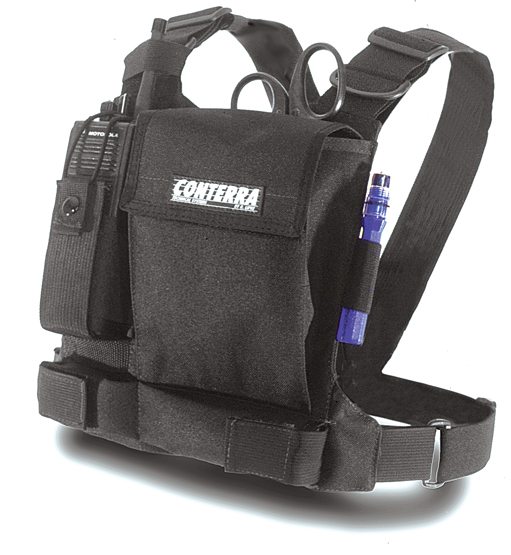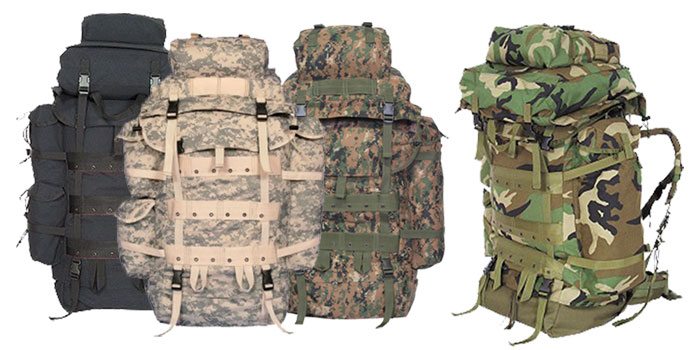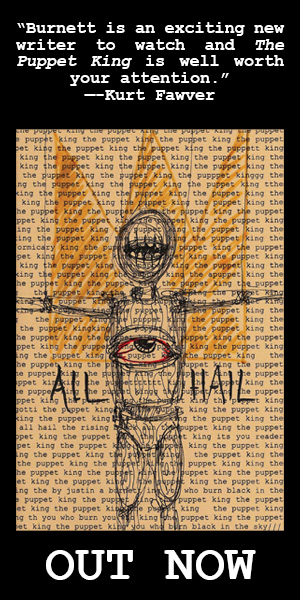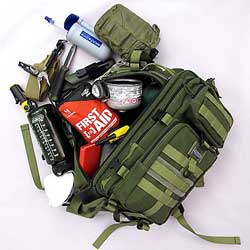
The answer to that is simple yet involved. The items you carry on your person, in your pockets, on your belt daily are exactly that, your EDC gear. Without looking like you’re carrying a Batman utility belt around your waist, you have items that you use daily either at work, home or when you venture out.
This topic will be describing some options of EDC gear and carry and how those items can supplement existing BOBs. We will also be discussing dividing and assigning BOBs by categories.
The BOB categories are:
Primary: This is the BOB that we have packed at home, as the name implies; it’s your primary BOB that will have all the goodies inside.
Vehicle: This is the BOB that remains in our vehicle that contains items we may need in the event we are away from home when TSHTF. A miniature or duplicate of our Primary.
Personal: This is the small pack that we take with us when we leave home to go to work, go shopping or out. This is a mini version of our primary BOB that contains items we may need to use to get back home that can be and should be supplemented by your vehicle BOB.
EDC: Every Day Carry, these are simple items that we have on our belt, in our pockets, in a waist bag or in our purse that supplement and augment our primary, personal and vehicle BOBs.
EDC and Layers
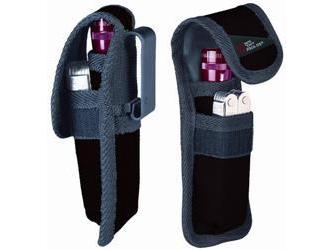
None of these items is required or necessary for everyone. Not all of us carry large amounts of gear as part of our EDC and what we do carry could be placed inside a purse, a waist bag, a small pack or in our pockets. The items we do carry on our person should be something that can be augmented with your primary BOB and our vehicle BOB (if you have a vehicle, again not required) that is in your car out in the parking lot. There is and should be an overlap between your EDC gear and all your BOBs.
What I mean is you don’t need to stuff your pockets with meal bars and shelter material if you already have those items in the BOB in your car. You don’t need to strap on your sheath knife if you have one if it’s more at home in or on your personal BOB. The only items you should have on your person are those items that do not draw unwanted attention to yourself and are small enough to clip to your belt, stuff in your pockets or wear. Remember that clothing can also be part of your BOB as it counts as shelter material. Here are the basic layers to EDC.
Layer 1 is what you have in your pockets.
Layer 2 is the items you add like belt pouches, load bearing vests/harnesses, etc.
Layer 3 is a waist bag, a backpack etc. Each layer increases the equipment and supplies you carry therefore increase your chances of survival. An example of Layer 1 EDC could consist of a 550 cord survival bracelet and a knife of some kind. Really, it’s that simple.
Personal BOB
Now that we have EDC gear pretty much sorted out let’s move to the Personal BOB. This BOB should be a small pack that you toss in the car when you leave home, leave in the car at work or while shopping and bring back in the house when you get home. It’s a miniature version of our primary BOB, some of us refer to this as the 24hr go to hell bag and it could fit the bill for either Layer 2 or 3. With 24hours of supplies in it, that is the time frame that you should plan to minimally survive and possibly thrive with our personal (Layer 2/3) BOB. Remember, it’s designed to get you out of the hot zone and back home.
You’re probably asking yourself what about the vehicle BOB?
Vehicle BOB
Your vehicle BOB is the one that you inspect monthly and remove and replace anything that needs to be replaced but it remains in your vehicle. EDC, your primary, personal BOB and your vehicle BOB all interact, supplement and augment each other. Not all of us have a vehicle or a vehicle large enough to store a BOB. If that’s the case, then don’t worry about it. But do keep this information handy for sometime in the future when you either get a vehicle or get a vehicle with enough cargo space to carry a vehicle BOB.
Did I lose anyone with that statement?
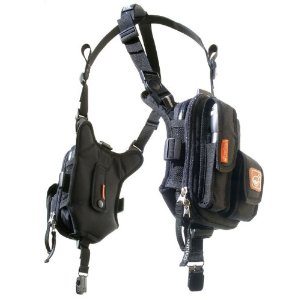
Is this confusing anyone?
We’ve talked about BOBs but haven’t talked about the overlap of EDC, primary, personal and vehicle BOBs. What we’re discussing is the level or layer of BOBs.
A simple way to grade your BOBs is to look at the layers as described under the EDC heading and adjust accordingly. Your personal BOB and EDC (and the two go together) should be a combination of Layer 1 and 2, the vehicle BOB is layer 3, be it in an ALCE pack, a CFP-90 or some other pack. That is a simple way to remember the levels/layers for a BOB.
By assigning grades or even color codes and utilizing the layer methods to your various BOBs you can feel confident that even if the shit hits the fan and all you have is your EDC and personal BOB you’ll still have enough gear and supplies to get out of the hot zone and back home.
Note: some of us may have a separate BOB that we label as the GOTH bag. Not all of us have a need for such an item. A GOTH bag is literally the Go To Hell bag that we fall back to when there is total and I stress, total, collapse of civilization. I know, that sounds a bit weird considering we’ve discussed BOBs and those kits are created for just such an occasion, but, a GOTH bag is designed to get you out of the hot zone in the event that there are riots, massive civil unrest and other incidents where there may be a very serious threat beyond the event itself and you may have to service hostiles before you clear the hot zone. Remember, civilization is really only tissue thin. Remove something that we all take for granted, like electricity and and the ability to call 911 for help and you’ll see roving gangs and mindless looting hordes that you never thought you’d see.
The 10 Essentials and the 15 Criticals
Let’s look at some of the things your personal BOB could contain. If you’re familiar with the 10 Essentials those are the core elements to any BOB.
1. Matches or some device that can make fire, i.e. lighter,
2. Firestarter (ferrocerrium rod or something similar)
3. Map
4. Compass
5. Flashlight
6. Food
7. Clothing*
8. 1st Aid Kit
9. Pocket Knife/Multi-tool
10. Shelter*
*Clothing and Shelter can and will overlap
As you can see, some of the 10 Essentials could be part of your EDC leaving you more room in your personal BOB for some of the 15 Criticals.
#1 Clothing* (can be shelter as well)
Dress for the worst conditions possible, layered clothing or some kind of Goretex outwear (could be part of your EDC already).
#2 Fire*
Water proof matches in 2 locations, a Ferrocerium Striker and a Lighter. (note that both the 10 Essentials and the 15 Criticals mentions some way to start a fire)
#3 Knife*
A quality Survival Knife (this would be a sheath knife).
#4 Whistle* (not required but handy for some of us)
#5 1st Aid Kit* (if your personal BOB already has one, then either insert a larger one of add more aid supplies) to supplement your Personal First Aid Kit.
#6 Signal Mirror*
High Quality Glass, can be found at most surplus stores or online.
#7 Compass*
Liquid Filled Sighting Compass, one addition to this, look at the Major Surplus and Survival website, you can usually get a 10 pack of small compasses that can be attached to your zipper pulls which is a great addition to your primary compass.
#8 Cord*
50ft (or more) of 550 paracord (if carrying more than 50ft of 550, its best to have it cut into 50ft lengths)
#9 Pot
2Ltr+ with a tight lid and handle/grip, a thermos or sports bottle works here as well, what you choose is up to you.
#10 Bow Saw
Folding Bow Saw or Bow Saw, may not be necessary for those of us who carry a multi-tool, most multi-tool have a saw blade. The Leatherman Wave and the Swiss Army Victorinix both have a saw blade and I carry both of those as part of my EDC. That’s my personal choice, what you carry is as always, up to you.
#11 Sleeping Bag & Protective Cover
Quality Synthetic Filled Mummy Bag, this is probably best left in the car or at home. You can get away with a Mylar emergency blanket in its place as your vehicle and primary BOB should already have this included.
#12 Mattress
Self Inflating Mattress or Ensolite Pad, again an item that should already be in your vehicle BOB and with your primary BOB.
#13 Shelter
Big enough for all occupants, what might work here would be a military surplus poncho/shelter half and it should also be in your vehicle BOB.
#14 Pack or Waterproof Container (kind what we’re already talking about, duh)
Big enough and sturdy enough to carry the 15CI’s.
#15 Extra Items:
These items could be in your vehicle BOB and your primary BOB
Survival Candle
2 Heavy Duty clear Garbage Bags 30 and/or 60 gallon size
Sunglasses, Sunhat, Suntan Lotion (these could be included in your personal BOB)
Mosquito Repellent and Bug Face Net
Water Proof Flashlight (+ Spare Batteries) (personal, vehicle and primary BOB)
Water Container (1L+), Water Purification Tablets, water filtration system (vehicle and primary BOB, maybe in your personal)
ORS (Oral Rehydration Solution) Snacks (High Energy) & Brew Kit= tea, coffee, cider, cocoa
Emergency rations (1 day’s food, at or above your BMR= Basic Meal Requirements) (vehicle, primary and maybe personal BOB)
Sharpening Stone or Board (vehicle and primary BOB)
Sewing Kit w/ Awl / Repair Kit w/ Duct Tape and Tie Wraps (vehicle and primary BOB maybe personal BOB)
Spare Insulative Clothing (vehicle, primary and personal BOB)
As you can see there are some major overlaps between the 10 Essentials and the 15 Criticals. Not everything listed is required for everyone. This is not a list that is set in stone of items you must have with you. These lists are just a starting point for all of us. What we end up carrying in our various BOBs will be up to each of us based on our location and what we’re expecting to deal with. You can also see how there are several items that are redundant or duplicated. This falls back to don’t put all your eggs in one basket statement. By having backups, you decrease the chance of losing a critical piece of equipment.

